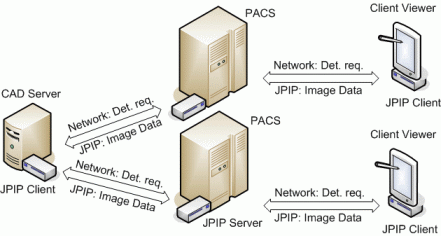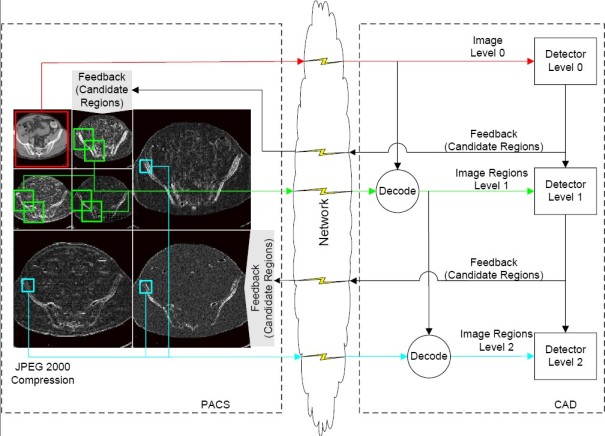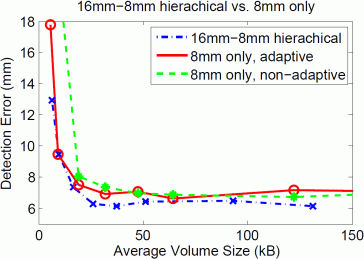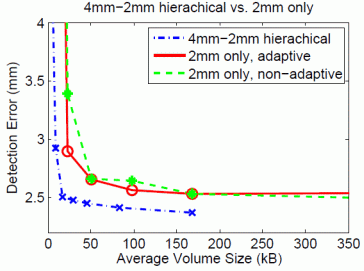|
Progressive Data Transmission for Hierarchical Detection in a Cloud (DiC)
This page gives a high level overview of our research on Detection in a Cloud (DiC).
For more details, please refer to our articles
published in HP-MICCAI 2010 proceedings and Methods of Information in Medicine journal.
Contents
Overview
In response to the growing need for image analysis services
in the cloud computing environment, this paper proposes an automatic
system for detecting landmarks in 3D volumes. The inherent problem of
limited bandwidth between a (thin) client, Data Center (DC), and Data
Analysis (DA) server is addressed by a hierarchical detection algorithm
that obtains data by progressively transmitting only image regions
required for processing. The client sends a request for a visualization of a
specific landmark. The algorithm obtains a coarse level image from DC
and outputs landmark location candidates. The coarse landmark location
candidates are then used to obtain image neighborhood regions at a finer
resolution level. The final location is computed as the robust mean of the
strongest candidates after refinement at the subsequent resolution levels.
The feedback about candidates detected at a coarser resolution makes it
possible to only transmit image regions surrounding these candidates at
a finer resolution rather then the entire images. Furthermore, the image
regions are lossy compressed with JPEG 2000. Together, these properties
amount to at least 50 times bandwidth reduction while achieving similar
accuracy when compared to an algorithm using the original data.
Motivation and Intuition
Figure 1:
The Detection in a Cloud (DiC) system is used by thin-client devices that
request the display of an anatomical part for a specific patient. The patient data
stored in a Data Center are transmitted to a high performance Data Analysis
server that runs the detection algorithm. (In the medical domain and also in this
paper, these servers are referred to as the Picture Archiving and Communication
System (PACS) and Computer Aided Detection (CAD) server, respectively). The
image with the anatomy highlighted is returned back to the client for display
(Figure 1).

|
We propose an efficient hierarchical learning-based detection system to avoid
the problem of transmitting large datasets. The system runs on the CAD server
that obtains portions of the original dataset from the PACS server on demand.
The algorithm starts detection on a downsampled low-resolution image that
has been compressed and transmitted to the CAD server. The coarse landmark
candidate positions define the regions in a finer resolution image, where the
coarse candidates are refined. The refinement steps continue until all levels of
the hierarchy have been processed. The final detection result is obtained by
robustly combining strongest candidates from the finest level.
Figure 2:
Overall DiC system diagram. The hierarchical detection algorithm progressively
obtains image regions required for detection at each level.

|
The amount of transmitted data is significantly reduced in the DiC system.
First, the algorithm only processes candidate regions at finer resolutions rather
than the entire images. Second, all image regions are compressed with a lossy
compression. When combined, these properties result in an overall reduction of
the original data size by a factor of 30 (CT data) and by a factor of 196 (MRI
data). Our experiments show that the lossy compression does not hinder the
final detection accuracy. The experiments also demonstrate the robustness and
accuracy of the hierarchical algorithm and advantages of training on compressed
images.
In summary, the paper makes three main contributions: (1) an overall system
for landmark detection using remote datasets, (2) hierarchical detection
algorithm with a local refinement, and (3) evaluation of training and detection
on images compressed with lossy 3D JPEG 2000.
Results
Figure 3:
Detection error vs. average volume size for hip bone landmark in CT (top)
and crista galli landmark in brain MRI (bottom). The images were compressed in training
and testing with the same pSNR level (adaptive) and uncompressed in training
and compressed in testing (nonadaptive). The hierarchical processing results in lowest
detection error through the focused coarse-to-fine search and training on compressed
volumes. The average size of the uncompressed and lossless-compressed volumes is: 404
kB and 189 kB (8 mm CT), 3334 kB and 985 kB (2 mm MRI).

|

|
Table 1:
The median detection error of the hierarchical detection on images
compressed at pSNR 70 (2nd and 5th column), on uncompressed images (3rd and 6th
column), and on a single resolution losslessly-compressed images (4th and 7th
column). The average size of uncompressed volumes is 3188 kB (4 mm CT) and 3334 kB
(2 mm MRI). The hierarchical algorithm trained with images of pSNR 70 requires the
least amount of data without sacrificing the detection accuracy.
| | CT | MRI |
| | 16-8-4 hier | 16-8-4 hier | 4 mm | 4-2 hier | 4-2 hier | 2 mm |
| | pSNR 70 | lossless | lossless | pSNR 70 | lossless | lossless |
| Error (mm) | 3.87 | 3.54 | 3.98 | 2.50 | 2.37 | 2.27 |
| Avg. Data Size (kB) | 106.22 | 393.45 | 1345.96 | 16.99 | 168.07 | 984.76 |
Summary
At the core of the Detection in a Cloud (DiC) is a
hierarchical learning algorithm that propagates position candidate hypotheses
across a hierarchy of classifiers during training and detection. The algorithm
only requires image regions surrounding the candidates which results in less
bandwidth for remote data access. Further bandwidth savings (without sacrificing
the detection accuracy) are achieved by compressing the images regions with
lossy JPEG 2000. The total bandwidth savings for retrieving remotely stored
data amount to 30 times (CT data) and 196.2 times (MRI data) reduction when
compared to the original data size and 12.7 times (CT) and 58.0 (MRI) when
compared to data size after lossless compression.
The proposed approach makes it possible to shift the integration, maintenance,
and software updates from the client to the CAD server. Therefore, when
the classifiers are updated, they are immediately available to all clients. In the
clinical environment, detected anatomical parts can be reviewed on the client
devices remotely. The current system opens many exciting future research directions
both on the algorithmic side as well as on the systems side. We are interested
the most in building more complicated models with several landmarks of
interest trained for different modalities. Such large scale systems will require coordination
of multiple CAD servers possibly distributed in a wide-area network.
Publications and Further Reading
|
Progressive Data Transmission for Anatomical Landmark Detection in a Cloud
Michal Sofka, Kristof Ralovich, Jingdan Zhang, S. Kevin Zhou, and Dorin Comaniciu
Methods of Information in Medicine, Invited Paper, vol. 51, no. 3, pp. 268-278, Jun. 2012.
[pdf]
[bibtex]
[publisher]
|
|
Progressive Data Transmission for Hierarchical Detection in a Cloud
Michal Sofka, Kristof Ralovich, Jingdan Zhang, S.Kevin Zhou, and Dorin Comaniciu
Proceedings of the 2nd International Workshop on High-Performance
Medical Image Computing for Image-Assisted Clinical Intervention
and Decision-Making (HP-MICCAI 2010), Bejing, China, 22 Sep 2010.
Best Paper Award.
[pdf]
[bibtex]
|
|